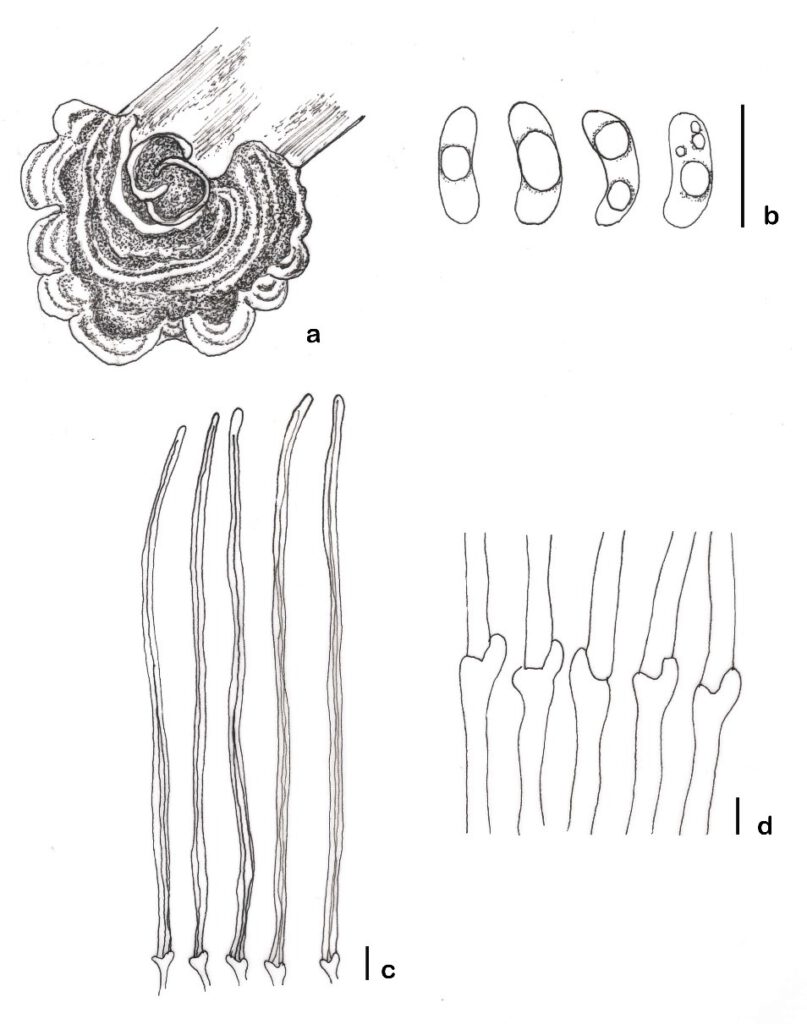Fungalpedia – Note 132 Auricularia
Auricularia Bull.
Citation if using this entry: Bera et al. (in prep) Basidiomycota. Mycosphere.
Index Fungorum, Facesoffungi, MycoBank, GenBank, Fig. 1
Basidiomycota, Agaricomycetes, Auriculariales, Auriculariaceae
The Latin meaning of “Auricularia” translates to “ear-shaped things”. This etymology aptly encapsulates the distinct appearance of the genus. Generally, all the species of this genus form gelatinous or jelly-like textured, ear-shaped, or sometimes shelf-like basidiocarps. Frequently recognized by the names “jelly ear fungus” and “wood ear fungus,” Auricularia was introduced by Pierre Bulliard in 1780 to accommodate all similar-looking mushrooms (Persoon 1822). Persoon (1822) refined the genus classification to encompass two solely gelatinous species: Auricularia mesenterica (Dicks.) Pers., which subsequently became the designated type species, and A. sambuci Pers., later recognized as a synonym for A. auricula-juda. With the growing count of species, Barrett (1910) and Kobayasi (1942) tried to differentiate the species by analyzing their macromorphological characteristics (Looney et al. 2013, Wu et al. 2015). Lowy (1951) introduced a classification system using hyphal internal stratification and emphasized that the presence of a medulla, mainly positioned centrally and running parallel through the middle of basidiomata, serves as a dependable trait. The existence of the medulla was later considered the basis of the classification of Auricularia (Lowy 1952, Kobayasi 1981).
The substipitate to resupinate Auricularia usually appears singly or in clusters. The upper surface of the basidiomata is either finely pilose or densely hirsute whereas the under-spore-bearing surface varies from smooth to veined or reticulate or wrinkled (Wu et al. 2014). Mostly Auricularia are brownish but white forms have also been rarely encountered (Reid 1970, Bandara et al. 2020). Micromorphologically, the basidia are transversely tri-septate, hyaline, cylindrical to clavate and contains oil guttules (Lowy 1951, 1952, Duncan & Macdonald 1967, Montoya-Alvarez et al. 2011, Wu et al. 2021). The basidiospores of the genus are usually allantoid (Parmasto & Parmasto 1987, Wu et al. 2021).
Nonetheless, the macro-morphological characteristics of all the Auricularia species exhibit variability, leading to imprecise differentiation of closely related species. Thereafter, the phylogenetic analysis solidifies the systematic position of the genus and shows that the members of Auricularia forms a natural, monophyletic group (Montoya-Alvarez et al. 2011, Looney et al. 2013, Wu et al. 2014, Wu et al. 2015). Recently, a combined study with morphology and multi-gene (nrITS, nrLSU, rpb1, and rpb2) phylogeny of 277 specimens from different countries of Asia, Europe, America, Africa, and Oceania was undertaken unveiling 37 Auricularia species (Wu et al. 2021).
The members of this genus have a worldwide distribution and are known for their ecological significance, economic value, and medicinal attributes (Wu et al. 2021). They are also an integral part of the forest ecosystem degradation, particularly within tropical forests. They typically thrive in angiosperm wood, such as deceased trees, stumps, fallen trunks, branches, and decaying wood (Dai & Bau 2007, Baldrian & Lindahl 2011, Wu et al. 2021). A limited number can also be found on gymnosperm wood (Dai & Bau 2007, Baldrian & Lindahl 2011, Wu et al. 2021).
Type species: Auricularia mesenterica (Dicks.) Pers.
Figure 1. Auricularia mesenterica a. Basidiomata. b. Basidiospores. c. Abhymenial hairs. d. Clamp connections of hyphae. Scale bars: b = 15 μm, c = 10 μm, d = 5 μm. Drawn from a & b = Wu et al. 2015, c & d = Ghosh et al. 2021.
References
Baldrian P, Lindahl B 2011 – Decomposition in forest ecosystems: after decades of research still novel findings. Fungal Ecology, 6(4), 359–361. https://www.infona.pl/resource/bwmeta1.element.elsevier-eb772245-f661-3cd1-ac62-a45fafd36cd9
Bandara AR, Mortimer PE, Vadthanarat S, Xingrong P, Karunarathna SC, Hyde KD, …Xu J 2020 – First successful domestication of a white strain of Auricularia cornea from Thailand. Studies in Fungi, 5(1), 420–434. https://www.maxapress.com/data/article/sif/preview/pdf/20200123.pdf
Barrett MF 1910 – Three common species of Auricularia. Mycologia, 2(1), 12–18. https://www.tandfonline.com/doi/abs/10.1080/00275514.1910.12020751?journalCode=umyc20
Dai YC, Bau T 2007 – Illustrations of Edible and Medicinal Fungi in Northeastern China. Science Press. https://www.cabdirect.org/cabdirect/abstract/20198644822
Duncan EG, Macdonald JA 1967 – Micro-evolution in Auricularia auricula. Mycologia, 59(5), 803-818. https://www.tandfonline.com/doi/abs/10.1080/00275514.1967.12018469
Ghosh S, Sett S, Saha R, Roy A, Acharya K 2021 – Comparative phytochemical screening and antioxidant properties of infusion, decoction and hydroalcoholic extracts of wood ear mushrooms; Auricularia delicata and Auricularia mesenterica. Indian Phytopathology, 74, 113–121. https://link.springer.com/article/10.1007/s42360-020-00301-3.
Kobayasi Y 1942 – On the genus Auricularia from Eastern Asia. Bull. Cen. Nat. Mus. Manchoukuo, 4, 19–35. https://eurekamag.com/research/025/802/025802245.php
Kobayasi Y 1981 – The genus Auricularia. Bull. Natn. Sci. Mus. Tokyo, 7, 41–67. https://books.google.co.th/books/about/The_Genus_Auricularia.html?id=c7ieXwAACAAJ&redir_esc=y
Looney BP, Birkebak JM, Matheny PB 2013 – Systematics of the genus Auricularia with an emphasis on species from the southeastern United States. North American Fungi, 8(6), 1–25. https://rex.libraries.wsu.edu/esploro/outputs/journalArticle/Systematics-of-the-genus-Auricularia-with/99900612196901842
Lowy B 1951 – A morphological basis for classifying the species of Auricularia. Mycologia, 43(3), 351–358. https://www.tandfonline.com/doi/abs/10.1080/00275514.1951.12024135?journalCode=umyc20
Lowy B 1952 – the genus Auricularia. Mycologia, 44(5), 656–692. https://www.tandfonline.com/doi/abs/10.1080/00275514.1952.12024226?journalCode=umyc20
Montoya-Alvarez AF, Hayakawa H, Minamya Y, Fukuda T, López-Quintero CA, Franco-Molano AE 2011 – Phylogenetic relationships and review of the species of Auricularia (Fungi: Basidiomycetes) in Colombia. Caldasia, 33(1), 55–66. http://www.scielo.org.co/scielo.php?pid=S0366-52322011000100003&script=sci_arttext&tlng=en
Parmasto E, Parmasto I 1987 – Variation of basidiospores in the hymenomycetes and-its significance to their taxonomy. Biblioth. Mycol., 115, 1–168. https://www.schweizerbart.de/publications/detail/isbn/9783443590161/Bibliotheca_Mycologica_Band_115
Persoon CH 1822 – Mycologia europaea (Vol. 1). https://books.google.co.th/books?hl=en&lr=&id=8lY-AAAAcAAJ&oi=fnd&pg=PA1&dq=info:EbF1-nRMi1cJ:scholar.google.com/&ots=_lZ0BtO1gh&sig=nFPf0dKOyRaLua5Q9GuetIynvdI&redir_esc=y#v=onepage&q&f=false
Reid DA 1970 – New or interesting records of British Hymenomycetes, IV. Transactions of the British Mycological Society, 55(3), 413–441. https://www.sciencedirect.com/science/article/abs/pii/S0007153670800626
Wu F, Tohtirjap A, Fan LF, Zhou LW, Alvarenga RL, Gibertoni TB, Dai YC 2021 – Global diversity and updated phylogeny of Auricularia (Auriculariales, Basidiomycota). Journal of Fungi, 7(11), 933. https://www.mdpi.com/2309-608X/7/11/933
Wu F, Yuan Y, Malysheva VF, Du P, Dai YC 2014 – Species clarification of the most important and cultivated Auricularia mushroom “Heimuer”: evidence from morphological and molecular data. Phytotaxa, 186(5), 241–253. https://www.researchgate.net/profile/Fang-Wu-20/publication/286670829_p_alignleft_Species_clarification_of_the_most_important_and_cultivated_Auricularia_mushroom_Heimuer_evidence_from_morphological_and_molecular_data_p/links/598453d9a6fdcc5291c9623f/p-alignleft-Species-clarification-of-the-most-important-and-cultivated-Auricularia-mushroom-Heimuer-evidence-from-morphological-and-molecular-data-p.pdf
Wu F, Yuan Y, Rivoire B, Dai YC 2015 – Phylogeny and diversity of the Auricularia mesenterica (Auriculariales, Basidiomycota) complex. Mycological Progress, 14, 1–9. https://link.springer.com/article/10.1007/s11557-015-1065-8
Entry by
Ishika Bera, Center of Excellence in Fungal Research, Mae Fah Luang University, Chiang Rai 57100, Thailand
(Edited by Kevin D Hyde)
Published online 8 September 2023
